Guppies are one of the most frequent tropical fish found in home aquariums. These fish are fantastic in your aquarium since they don’t bother the other species. These little fish can survive in your aquarium as long as the water temperature is right for them. The great thing about guppies is that they are pretty laid-back.
They will be content as long as you feed them and keep their water at the proper temperature. You can constantly keep your fish tank at the right temperature by using a heater and a thermometer. These tropical fish don’t perform well in cooler water since they’re tropical. Read our guide to know more about guppies and looking after them, read out guide.
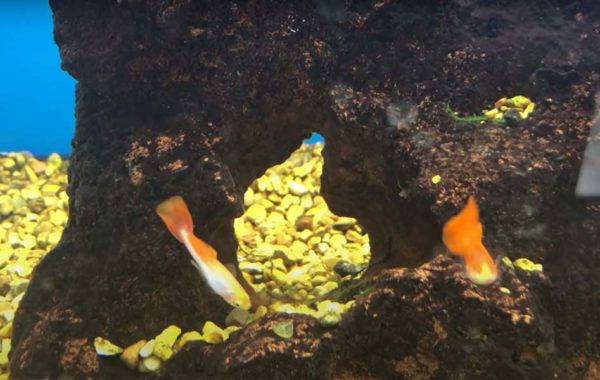
Table of Contents
Guppy Fish Water Temperature: Quick Overview
Guppy fish prefer water temperatures between 72-82°F. It is important to maintain a consistent temperature and avoid sudden changes, as this can cause stress and illness in the fish.
What’s the maximum Temperature Guppies Can Survive In?
A guppy’s maximum temperature for survival is 90 degrees Fahrenheit (32 C). They can only stay in the water for a short time once it reaches this temperature. Whenever the water in a guppy’s tank overheats, the guppy’s metabolism speeds up. This causes them to be even more hyperactive.
All the increased activity can induce stress in the guppy. Stress is one of the leading causes of aquarium fish death. This is because all of the added stress from moving might damage their immune system. In addition, diseases and parasites might damage your guppy even if you don’t expose it to temperature changes for a long time.
This is why it’s essential to keep a check on your thermometer to ensure that their water remains within the acceptable temperature range. A distressed fish, due to temperature, is more likely to succumb to illnesses. In addition, fish breathe oxygen derived from the water because hot water can’t store as much oxygen as cold water.
There may not be enough oxygen to circulate throughout the aquarium if the temperature becomes too high. Your guppies may suffocate as a result of this. To complicate matters further, the water in every fish tank contains helpful microorganisms. The bacteria will not break down ammonia in the tank when the temperature is too high. Ammonia buildup in the tank can cause the guppy’s gills to burn.
What’s the Minimum Temperature Guppies Can Survive In?
Guppies are tropical fish that thrive in hotter environments. This implies you should never maintain them in water below 60 degrees Fahrenheit (16 C). Guppies are not intended to dwell in cold water and can endure if temperatures dip that low. Coldwater reduces their activity level, which leads to further problems. The problem with chilly tanks is that they might have difficulty reproducing or may stop reproducing completely.
Guppies need warmer temperature ranges to live, so keeping them in a chilly tank puts them in danger of illness. In addition, some of the diseases to which they are vulnerable may result in their death. In a frigid tank, guppies feel the same way you would if you walked outside in the winter without a jacket.
When the water temperature drops in nature, the fish can travel to warmer waters. Since you can’t do that in an aquarium, you must regulate the temperature in the proper range.
Do Guppies need a heater?
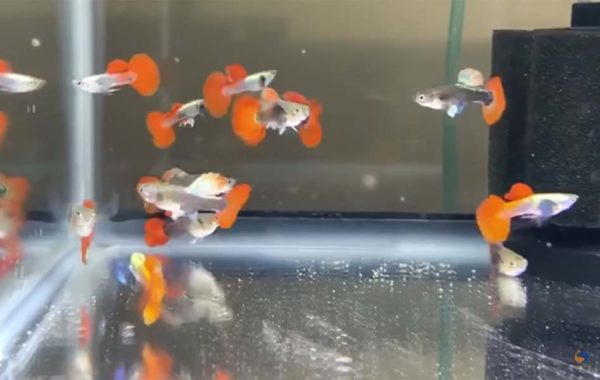
A heater for your fish tank is essential unless you live in a tropical environment. For example, guppies are only found in the Amazon. Here the temperature never falls below 73 degrees Fahrenheit. They cannot live in the frigid temperatures experienced in North America and the United Kingdom. You’ll need a heater for your guppies if you want them to feel at ease. They will be in danger of various ailments if you do not maintain their water warm enough.
How to create a suitable temperature for your guppies?
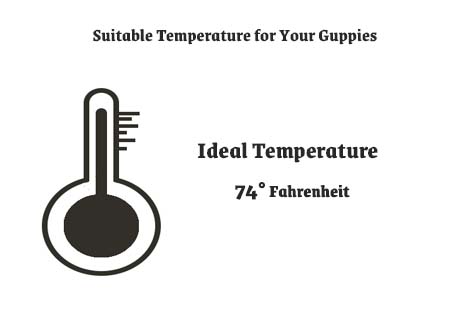
Keep a thermometer in your aquarium at all times so you can track the temperature range. If the temperature in your guppy’s tank drops below 74 degrees Fahrenheit, you must intervene to prevent the guppies from being unwell. To regulate the temperature in your aquarium, you’ll need a heater. Be sure to buy a heater of the proper size for your tank. If your heater does not have the appropriate wattage for your tank size, you may not heat the water sufficiently.
What happens when the water is too warm?
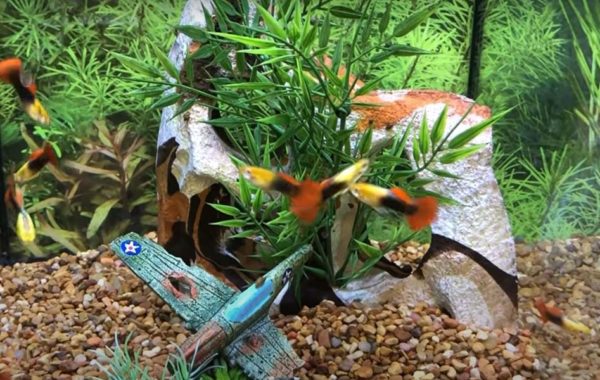
Your guppies may be unable to breathe if the water becomes too hot. You’ll want to take care of this as soon as you detect it. If the temperature inside your home is too high, your fish tank is likely to be uncomfortable. When the water temperature rises above 82 degrees Fahrenheit, it’s time to act. If there is thermostat-controlled heating and cooling, turn it on to cool things down.
While the light shining through the windows may appear pleasant, it is also heating the water in your tank. To keep the sun out, try to cover all the windows with shades. Also, since lights generate heat, it’s better to switch off the aquarium lights.
Until the water cools down, try to keep things as dark as possible. It’s wise to release the cover so the heat doesn’t get trapped in the tank. If any of your fish tend to leap, you’ll have to be cautious. You can do a few things now that the top is off to assist chill the water down faster for your guppies.
If there’s a cool-air fan available, turn it on and place it facing the top of your fish tank to chill things down. To achieve the appropriate height, you may need to put it on a chair or stool. Another option for cooling the water is to place some floating ice packs on top of it and let them melt. If you don’t want to shock the fish by making the water overly cold, don’t put ice cubes in it straight. Instead, choose only floatable ice packs.
What is the suitable temperature and pH balance for guppies breeding?
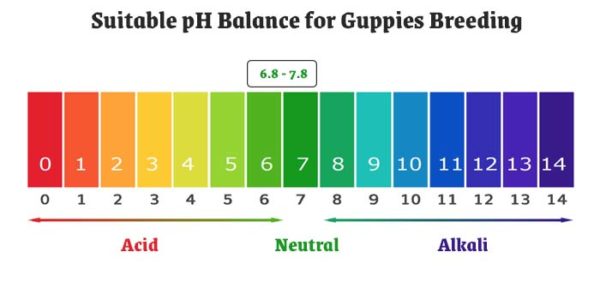
Hard water with a pH balance of 6.8 to 7.8 is healthier for guppies. Since most of the town’s tap water has a pH balance of 7.6, this makes life simpler for many individuals. Guppies flourish in this environment because it is just right.
Guppies need to be fed a few times an afternoon. It could be very crucial now to no longer over-feed your Guppy. All meals need to be fed after a few minutes. If there’s food left even after a few minutes, you’re feeding your Guppy an excessive amount of meals in a single serving. Although a flake meals food regimen is a superb base for the Guppy, it needs to be supplemented with live feeds. Live or frozen brine shrimp is a favorite Guppy fish meal, considering that brine shrimp could be very smooth to provide at home.
Guppies are smooth to reproduce in aquariums. They’ll spawn with no greater encouragement from their keeper. The mom Guppy needs to be lowered again, then back to her ordinary aquarium.
The water first-rate withinside the fry aquarium needs to be stored in the best condition. It needs to be stored easily, and water adjustments need to be adjusted at least three instances a week. You must feed guppy fry more frequently than Guppy fish, and 4 or 5 feedings an afternoon are encouraged. Please wait until the fry is 2.5cm lengthy earlier than allow them to live with other fish.
Wrapping Up
Guppys are so peaceful that they are often stored in community aquariums. It is best stored in the species aquarium, as other fish can pinch and attack long fins. When some guppies are kept together, they make a great school. Guppies are such laid-back fish that they don’t need much to be content. However, if their water isn’t at the optimal temperature, they might suffer from various illnesses.
Unfortunately, guppies sold in pet stores can be pretty weak. The males are very colorful and have a modified anal fin called Gonopodium. It looks like a pointed horizontal rod under the belly. Females are usually large, less colored, and have fan-shaped anal fins behind the stomach. They give birth every 30 days and precede their youth unless you provide them with plenty of hiding places. Guppy is one of the best fish for beginners and veterans due to its stunning appearance, small size. Guppies always grow in water comparable to the water in which they were born. Since guppies are native to tropical regions, their optimal water temperature is between 74 and 82 degrees Fahrenheit. While this is a large range, keep in mind that guppies need a constant temperature to be healthy. Don’t adjust their temperature to more than 2 degrees within a day. To know more about different types of Guppies, click here.
No related posts.
